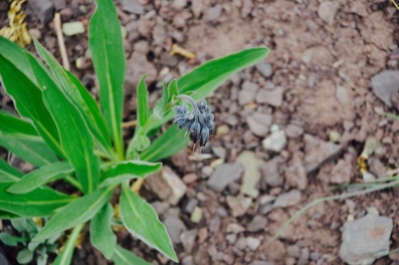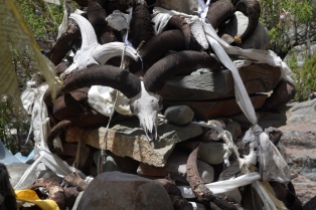“Out of your comfort zone”
These were the words that stood out for me when Rikzin briefed us an evening before our trek. We were to walk about 45 kms over 4 days, cross a pass at 15000 ft (4570m) above mean sea level climbing up from 11,800 ft (3200m) and we were to descend all of those 3,500 ft in a single day! But none of these numbers featured in that briefing we got on. We were, instead, taken through the mechanics, the process. What we would carry into our bag packs: water, packed lunch, sun screen, cap, etc and sandals for river crossings. What the campsite would be like: tents, sleeping bags, kitchen amenities, how we would shit… The only numbers we got, and we held on to these closely, was how many hours we would walk: 3-4 hours on day 1, 5-6 hours on days 2 and 3, and maybe 7+ hours on day 4 on the descent. We listened in rapt attention, especially the kids (aged 14, 14, 11, and 10). I remember thinking this was going to be a challenge. I remember feeling a flutter of excitement in my belly! In all of my 42 years on this planet, I had never gone camping and slept in a tent before and I felt every bit as excited as I had been on my first airplane ride or my first roller coaster experience!
What followed simply blew my mind. This had been the most physically arduous and mentally challenging experience of my life. And yet, at the end of each day, I felt a sense of calm as if I was destined to achieve. No matter how much I struggled while walking, I had not an iota of self doubt left at the end of each day’s journey. I discovered that the mountains and the unique sense of solitude and peace that nature offers, is empowering and transformative in a way that modern ‘world travel’, with its kaleidoscope of sensory experiences, cannot be.
Day 1: Stepping over stones, learning to breathe
We drove to Stok village in two slightly beat-up Maruti Suzuki Omnis. Right off the bat, the kids decided to be their own gang, riding in one car while the adults were assigned to the other. At the starting point of our trek, the sight of the 20-odd mountain horses being loaded with stuff, was a bit of a shock. I hadn’t realized what a massive logistical exercise it is, taking a group of city folks into the mountains! The sun beat down quite harshly on us that day and we sat around a joked, waiting for permits to be issued and the loading to finish. Suhani and Aadyaa, our youngest duo, put up an impromptu performance of a rap number they had been composing the past couple of days while we drove all the way to Pangong Tso Lake and back. Srijaa and Udai, the older kids, obliged and we have a few funky posed pre-trek shots from these moments.
We had a late start, mostly because our travel companions showed up late at the starting point, and it was very hot as we walked up along the Stok river past village homes and quaint home stays. The older kids set a robust pace, while we took our own time, enjoying the gradual fading away of human habitat and taking in the spectacular beauty before us. The walk involved stepping over large stones alongside gurgling water and though the climb was gentle, it was taxing on the ankles and knees. My pace dropped as we walked and the younger kids went ahead of us, accompanied by Govindji who was the man in charge on this trek. After two hours of walking, I started to struggle in earnest and it took effort to keep the breath steady and handle the harsh sun and dehydration. Yet, almost before we knew it, we hit the campsite at Changma and saw that much of it was already set up! The children had already reached and were busy with popcorn. Soon they were at the river, splashing about in the water and playing with Wilde, the dog from Stok village who had accompanied us all the way here. We also walked over and introduced ourselves to other campers nearby and befriended Adrian, a South African teacher who was traveling with schoolchildren from Jakarta. A long discussion on trekking in the Himalayas and the experience of working with local communities ensued. In a separate chat, Govindji lamented the lack of government infrastructure for trekkers.

Ladakh’s green valleys strike a sharp contrast in its brown landscape and we enjoyed the experience of walking out of one into the brown-ness beyond
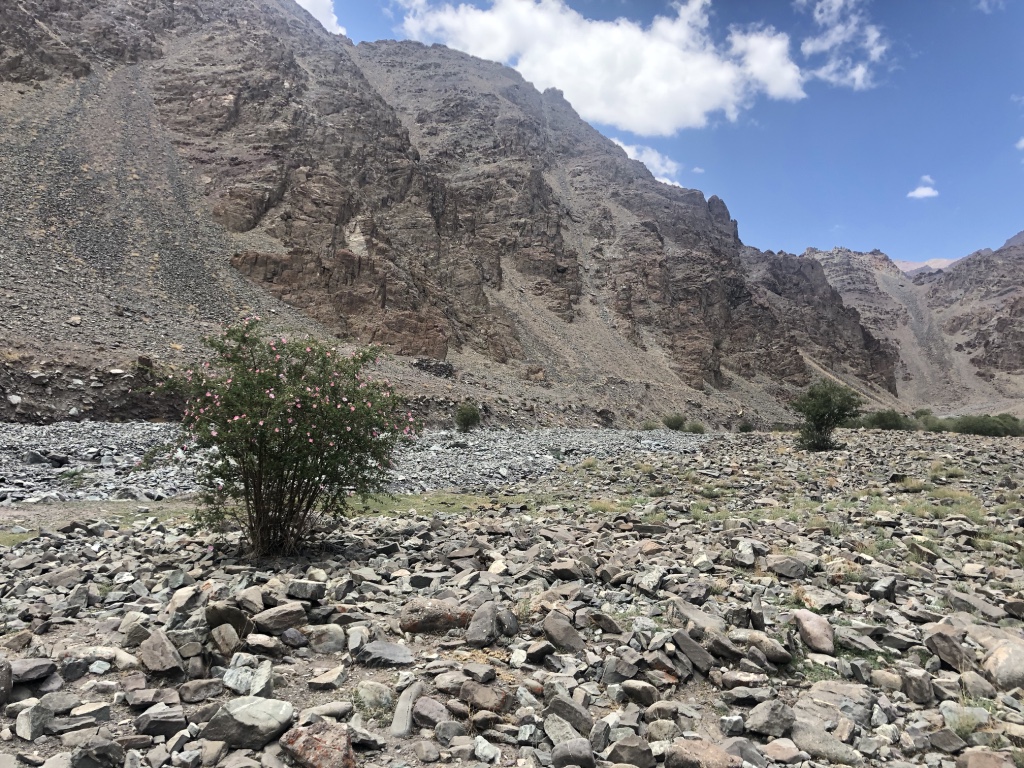
The flora alongside the river and the path that cut through the topsy turvy stones

Heading into the gorge


One step before the other!

Doggedness is all you need here…and when you are literally being encouraged by a dog friend, it’s a new kind of fun!
This slideshow requires JavaScript.

Pen and ink sketch of the campsite.Wherever I could, I doodled and sketched, and maintained a diary through the trek. Those entries have helped me immensely in reconstructing the trek for this post.
The campsites were made as comfortable as possible by the organizing team at Ladakh Sarai. The first to be set up were kitchen and dining tents, then two toilet tents that essentially offered some privacy and the option of a metal seat over a hole in the ground! A special mention for the excellent quality of food and the thoughtful preparations made by Chef Norbu, whose talent at cooking with minimal resources was surpassed only by his dazzling smile and affection.
After a good meal (mutton, dal, rice, vegetables, and an exotic chocolate-based dessert! wow!) and some time spent by the bonfire, we prepared for the night and zipped ourselves into the tents. The kids decided to sleep in one tent and seemed quite comfortable and cozy inside but for me, the first night was an adventure that involved grappling with a sleeping bag, fighting off claustrophobia and the fear of having to go out into the cold and pee!
Day 2: Walking over ice, gaining confidence
Even so, the next morning dawned bright and fresh, but not super early. We got ready quickly, breakfasted and packed to leave. The children were sent out onto the trail 30 minutes before us. Govindji had briefed them well and all four of them were to walk in line with the older ones forming the edges and the younger ones in the centre. He took them to where the trail began and sent them off and that enduring image of them setting out on their own, excited and confident an thick-as-thieves, is imprinted in my mind as one of the best memories of the trip.

Govindji got back and packed us off too, then moved on to the arduous job of winding up the camp and sending the horses onto the next campsite. The four of us- Rahul, Rishi, Shubha and me- walked to the trailhead and stood there gaping at the sheer climb ahead of us. Believe me, it was a path fit for mountain goats, but we braved that first climb by channeling all our learning from Day 1, pacing ourselves out much better, breathing evenly and most importantly, by discarding the idea of failure. After going over the first pass, we rejoined the path alongside the Stok river and from then on the climb was more steady, more scenic. We found ourselves in a narrow gorge, the jagged form of the mountain seemed to towers over us and almost close in on us, framing a patch of bright blue sky.
This slideshow requires JavaScript.
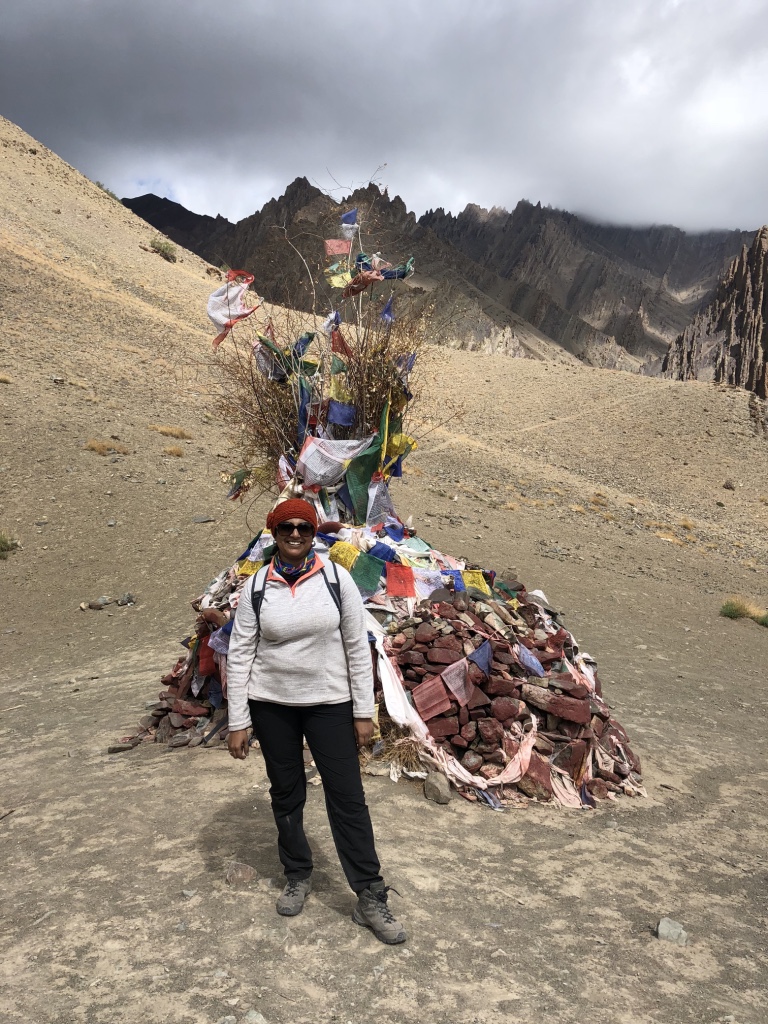
Small victories, great joys!
After maybe 90 minutes of walking, we spotted the children ahead, bright colourful dots arranged in a neat row at the edge of a sheet of glacial ice! The ice beckoned us and though the kids were gone by the time we got there, our energies were revived by the excitement of walking over ice. Shortly afterward, we reached a river crossing and found the kids waiting for us there, eating their packed lunch. From this point, those intending to scale Stok Kangri took one path towards base camp, while we took another path that climbed higher and higher on the edge of a mountain that overlooked the frozen parts of the river, many hundred feet below.
This bit of the trek was difficult too, demanding a sure footing and strong sense of balance. At one point, we were climbing up on all fours. Once again, the children did remarkably well and I was definitely the straggler. But by this time, I didn’t care. I was starting to get the hang of this.

Look at what’s ahead, more riverside scrambling over rocks!

‘Bhoot ki tatti’, this red sediment on the rocks would be a common sight

As far as the eye can see
This slideshow requires JavaScript.
We reached an extremely windy campsite. Everything was threatening to fly away and the team was struggling to set it up. Our kids had been smart and ensconced themselves inside the cozy and warm kitchen tent, where they helped out by peeling onion and garlic and cutting vegetables in industrial quantities. Learning from Day 1, we all ate the delectable pulao that cook rustled and then hung around the dining tent and wherever else we could find respite from the winds. The kids huddled inside their tent from where sounds of talking, giggling and eventually singing emerged!
[The children’s] chirpy voices, sometimes in conversation and other times in song, served as a fitful background score for a brief rest. Rahul napped while I read some, but the tent was too warm and eventually we have found refuge in the dining tent, sheltered from the howling wind which is literally sweeping our things away!
Diary entry, 16 June, 2018
The afternoon was considerably brightened by the surprise arrival of Rikzin, who had caught up with us and would be with us for the remaining part of the trek. The other bright spot was the baby marmot that emerged from his subterranean home from time to time to peer at us in frank curiosity. Out there on the hillside opposite us, the camp staff helped me train my binoculars on a marmot pair cavorting around and sunning themselves.
By sunset, the exhaustion of the day and the substantially higher altitude had begun to take a toll. The cure for crankiness, headaches and general despondency was apparently hot and peppery garlic soup, which Govindji gently urged the children to drink. Dinner was early and delicious, this time with chicken, dal and vegetables followed by a friend banana and cream dessert!
We had walked a lot more, gained considerable in elevation and I had not rested in the afternoon; so the night was spent negotiating a slightly better relationship with my sleeping bag and sleeping a little bit better. And also losing the fear of visiting the toilet in pitch darkness!

The starkness of this campsite was beautiful, but also harsh

Kitchen elves!
Day 3: Scaling Matho-La, accepting solitude
We woke up to a teen birthday (Srijaa’s) and the day started with wishes and hugs, and bonhomie over tea and breakfast! Aadyaa decided to walk with us instead of going ahead with the children. She had been a bit more affected by the altitude and the cold. Rikzin set the older kids off on a brisk pace and we went back along the partially frozen river. This was a day of spectacular views, mostly uncaptured on camera because of the arduousness of the climb. As we pushed toward the Matho La Pass, oxygen levels dropped and it became harder to walk.
It was a morning in which I found myself retreating into myself. The solitary and silent walk set off a train of introspection that had me thinking deeply about my goals in life, and the meaning and impact of ambition on myself and my loved ones. I found that while Rahul and my dearest friends were in plain sight, some ahead and some behind me, what really mattered was my own dogged determination to plant one foot before the other. I also felt a lot of my anxiety about my PhD leaving me. Working full time and pursuing a PhD program has meant that I am constantly worrying about not doing enough, being distracted and falling behind. But out there on the stark mountainside, I realized the only thing that mattered was to keep moving ahead. I felt light in mind, even as my trudge became slower and heavier, my breathing more laboured.

Colours and texture that are imprinted in my soul

An unending shifting landscape of texture and form

Getting closer!

Undeterred
Reaching Matho La pass was not just an endorsement of our endurance. We were treated with an enchanting view of the snow peaked mountains on the horizon and between us and that range of peaks lay a green valley dotted with flowers and all manner of plants, with the grazing dzo scattered here and there! The entire group was enchanted and relaxed. We sat in clusters snacking and chatting. We laughed and hugged. We clicked pictures and we strolled and ambled till we reached our campsite, the prettiest one yet.
This slideshow requires JavaScript.


 In the camp, a leisurely afternoon was spent ambling by the river (and some us actually managed to dip in those icy waters), reading, playing cards and story cubes (a story building game) and working on puzzles. The camp took time to set up as the horses reached late, offering us an opportunity to enjoy the grassy glade we found ourselves in, the prettiest campsite of all!
In the camp, a leisurely afternoon was spent ambling by the river (and some us actually managed to dip in those icy waters), reading, playing cards and story cubes (a story building game) and working on puzzles. The camp took time to set up as the horses reached late, offering us an opportunity to enjoy the grassy glade we found ourselves in, the prettiest campsite of all!
Rahul and me waited it out sitting on a rock and watching, as the crew set ip camp. Particularly interesting was the mind who minded the horses.. His rugged and wind-worn features and his slight build seemed typical of most ‘horse men’ we encountered in Ladakh. He whistled and hummed as he wound up the saddled and other paraphernalia, occasionally changing tone to call out the horses who were grazing nearby. There were certain sounds to send them away and calls to calm them down, and maybe others that we could not understand.
Diary entry, 17th June
The highlight of the evening was the feast to celebrate Srijaa’s birthday. Norbu’s phenomenal talent was unveiled to us as he awed us with a carrot cake with chocolate topping, mutton momos, pizzas with a do-your-own-topping option, noodles and chilli paneer, all on a regular LPG gas stove! How we ate that night! And how we appreciated the heat from the bonfire, made of dzo dung, before we settled into our tents for the coldest night of all.
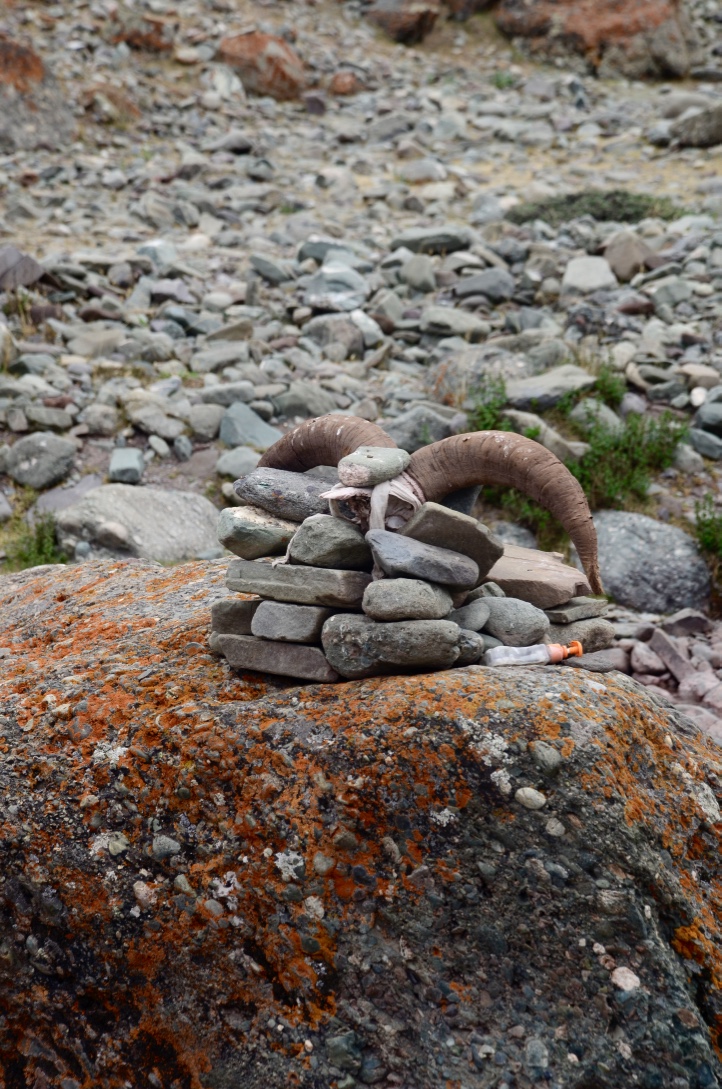
This slideshow requires JavaScript.
Sleeping at 14000 ft (4270m) was an interesting experience and I dealt with my tent issues by simply spending an hour in the middle of the night reading on my Kindle while Rahul snored, instead of pestering him about my sleeplessness and discomfort as I had done the last two nights!
This slideshow requires JavaScript.
Day 4: Enjoying the bounties of nature, testing my endurance
We walked over 18km on this last day of the trek. My shoes came apart and I did about a third of that in sandals, which meant hurting ankles and extreme exhaustion. We woke up to snow flurries at 14000 ft and came down to the sweltering sun of the valley. We crossed the river a dozen times, and our water bottle (its name was Vinod, yes we named our water bottles!) tried very hard to sacrifice itself to the river but we were adamant on saving it.
We experienced the largest diversity of flora in our time in Ladakh on this last day, the widest array of landscapes too. One time, we walked on a sliver of the mountain, with a steep fall away on either side. The feeling was spectacular but we worried intensely about our vertiginous companion, and spent some tense moments which fortunately ended in a short burst of relieved tears.
We saw pashmina sheep stuffed into a pen high on the mountains and met shepherds who were carrying back firewood supplies on donkey backs. Another time, we met nomads walking from Leh to Zanskar with enough words of Hindi and English on them to have a conversation!
Overall the descent was easier on our lungs but harder on knees and ankles, but we felt like we had to take in the sights and enjoy each part of the journey. Both Udai and Aadyaa walked with us and I remember the day as a kaleidoscope of images, conversations. The last several kilometres when extreme fatigue had set in, I was amazed at watching Aadyaa. All of ten, she walked alone, choreographing a dance number in her head, oblivious of her rhythmic gait, arm movements and expressions!

Countless river crossings

Udai contemplates the flowing water

A moment of repose
This slideshow requires JavaScript.
This slideshow requires JavaScript.

Traveling long distances for basic supplies is only one part of the hard life that Ladakhis lead

A classic Ladakhi scene

The river bed and the sky
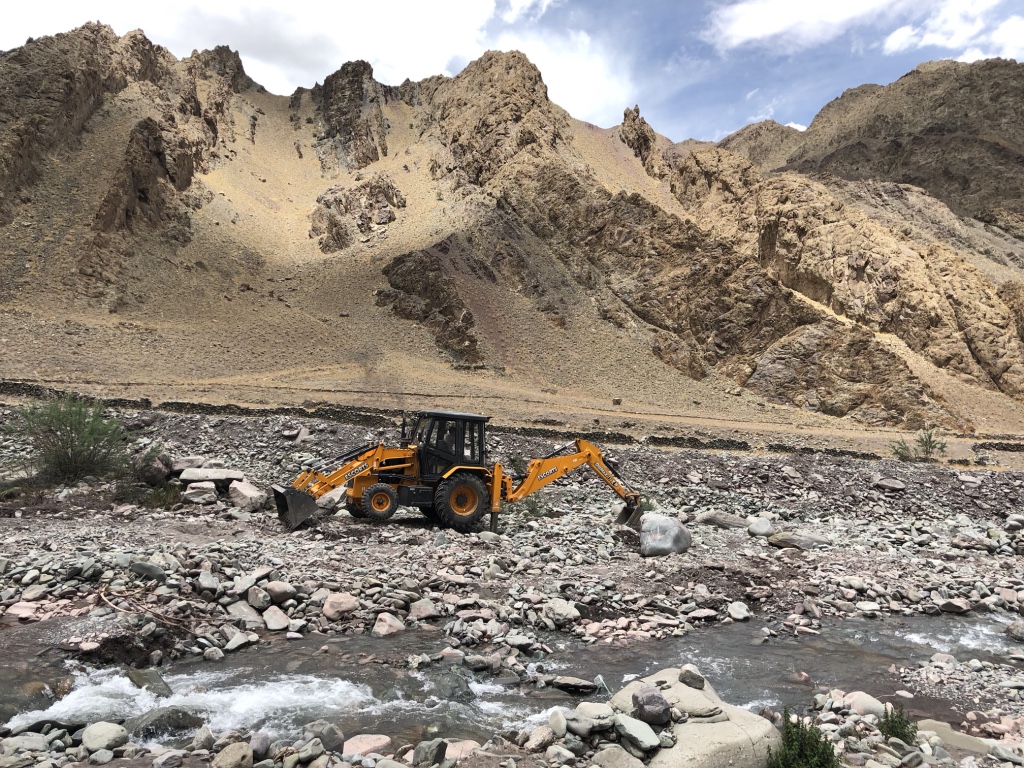
Yes the JCB is in Ladakh too, here its helping lay a water pipeline to Matho village

You might find them gruesome, but these altars with the parts of sacrificed animals mark the edges of village territoried. We found a couple on our route
As the monastery of Thiksey came into view in the distance, signalling the end of the 4-day trek, I found myself wishing intensely that this would never end, even as my feet screamed at me to stop immediately. At Matho village where we ended the trek, I felt happy and numb at the same time and all I could think of was a hot shower and a bed!
Back at the hotel, reunited with the others in the group, we conceded that the real stars of the trip had been the following: 1- The kids, who didn’t whine even once and banded together through thick and thin; 2- Govindji, whose advice and gentle persuasion tided us over many rough patches; and 3- Norbu, without whom we would not have had the kind of wholesome and soul satisfying nourishment we had through these four awesome days. Finally, a word on Rikzin’s enthusiasm, thoroughness and sheer passion for Ladakh and its outdoor treasures. To him goes the credit for preparing the kids (and us) mentally, putting the ambitious trek together and making sure the city slickers made it through just fine!



















































 In the camp, a leisurely afternoon was spent ambling by the river (and some us actually managed to dip in those icy waters), reading, playing cards and story cubes (a story building game) and working on puzzles. The camp took time to set up as the horses reached late, offering us an opportunity to enjoy the grassy glade we found ourselves in, the prettiest campsite of all!
In the camp, a leisurely afternoon was spent ambling by the river (and some us actually managed to dip in those icy waters), reading, playing cards and story cubes (a story building game) and working on puzzles. The camp took time to set up as the horses reached late, offering us an opportunity to enjoy the grassy glade we found ourselves in, the prettiest campsite of all!



